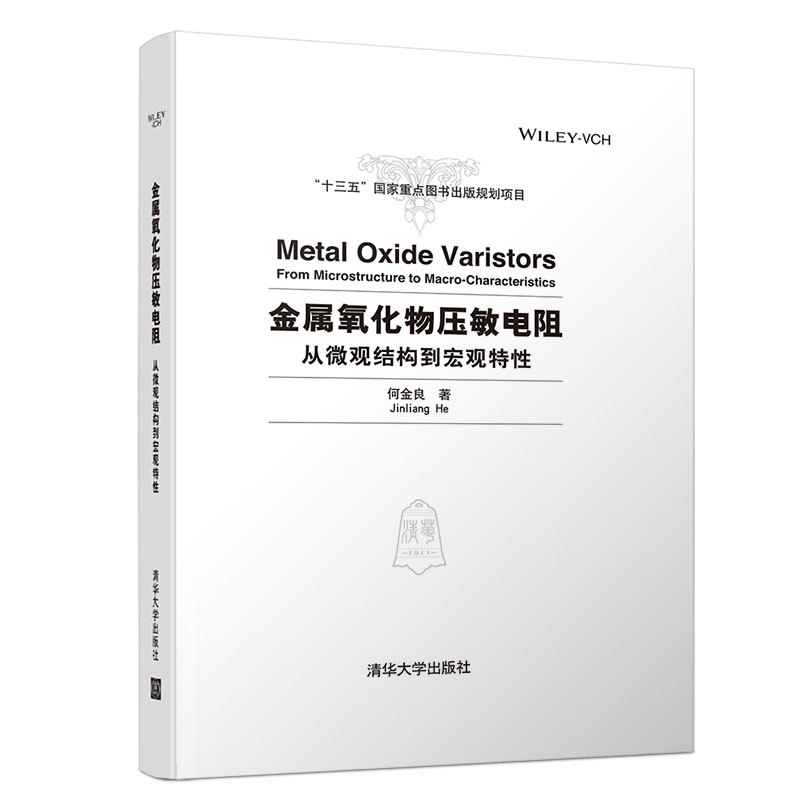





作者:何金良
定价:158元
印次:1-1
ISBN:9787302533368
出版日期:2019.08.01
印刷日期:2019.08.07
图书责编:黎强
图书分类:学术专著
金属氧化物压敏电阻是电力和电子系统的关键保护器件,直接决定系统运行的安全可靠性。本书系统介绍了氧化锌等压敏电阻的基础研究、制备工艺、性能调控及应用进展,包括导电及老化机理、微结构电特性、微结构测试及微结构仿真分析、高梯度低残压氧化压敏陶瓷、氧化钛及氧化锡等其他体系压敏陶瓷的研究进展等,构建了压敏电阻微结构特性与宏观特性之间的关联性。 本书可供高校和科研院所电气工程、微电子、材料等专业的师生以及电力传输、电气设备制造等行业的工程技术人员阅读和参考。
何金良教授1994年在清华大学获得博士学位。于1994年4月开始在清华大学电机系任教,2001年提升为教授。1997年至1998年期间,为韩国电气研究所电材料部访问科学家。目前,他是清华大学高压研究所所长,主要从事电介质材料和电工陶瓷、避雷器技术、电力系统及电子系统的电磁暂态和电磁兼容、先进电能传输技术等方面的研究。何金良教授在国际著名刊物发表论文130余篇,在中文核心期刊发表论文150余篇,在重要国际会议发表论文150余篇,同时合作编写6本专著及教材。获国家发明二等奖一次,省部级科技进步奖12项,是2008年亚太电磁环境国际会议暨第19届苏伊士电磁兼容国际会议优秀学生论文的合著者。2007年因在电能传输系统的雷电防护和接地技术方面的杰出成就而被评为IEEE会士。2010年获得IEEE电磁兼容学会的“技术成就奖”,2011年获得IEEE电磁兼容学会的“致谢证书”。何金良教授2004年荣获国家杰出青年基金,2010年被聘为教育部“长江学者特聘教授”。胡军博士1998年、2000年、2008年在清华大学分获学士学位、硕士学位和博士学位。2008年开始在清华大学从事博士后研究,2010年8月开始在清华大学
Metal oxide varistor (MOV), or ZnO varistor, is a kind of polycrystallinesemiconductor ceramics composed of multiple metal oxides and sinteredby conventional ceramic technology. ZnO varistors have good nonlinearvolt-ampere characteristics and excellent impulse energy-absorbing capacities.These advantages make them widely used in transient overvoltage protectionsfor electrical/electronic systems. Now, varistors have been widely used asguardianstoprotectcircuitsoveraverywiderangeofvoltages,fromafewvoltsin semiconductor circuits to 1000kV AC and ㊣ 1100kV DC in electrical power transmission and distribution networks. Correspondingly, they can also handlean enormous range of energies from a few j...
1.1 ZnOVaristors 1
1.2 FabricationofZnOVaristors 3
1.2.1 PreparationofRawMaterials 4
1.2.2 SinteringofZnOVaristors 5
1.3 Microstructure 6
1.4 TypicalParametersofZnOVaristors 7
1.5 HistoryofZnOVaristors 9
1.6 ApplicationsofZnOVaristors 12
1.7 AlternativeVaristorCeramics 17
1.8 Ceramic每PolymerCompositeVaristors 18 References 22
2 Conduction Mechanisms of ZnO Varistors 31
2.1 Introduction 31
2.2 BasicConceptsinSolid-StatePhysics 33
2.2.1 AtomicEnergyLevelandEnergyBandofCrystal 33
2.2.2 Metal,Semiconductor,andInsulator 35
2.2.3 CharacteristicsofFermi每DiracFunction 37
2.2.4 ImpurityandDefectEnergyLevel 38
... 查看详情
本书可供高校和科研院所电气工程、微电子、材料等专业的师生以及电力传输、电气设备制造等行业的工程技术人员阅读和参考。
查看详情



 电子书
电子书
 在线购买
在线购买
 分享
分享







